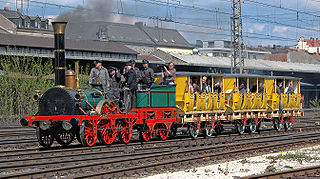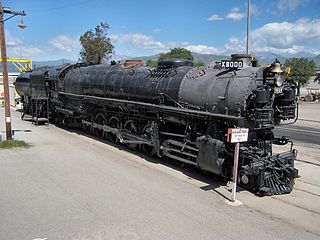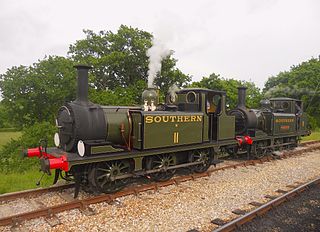
A steam locomotive is a locomotive that provides the force to move itself and other vehicles by means of the expansion of steam. It is fuelled by burning combustible material to heat water in the locomotive's boiler to the point where it becomes gaseous and its volume increases 1,700 times. Functionally, it is a steam engine on wheels.

A tank locomotive or tank engine is a steam locomotive which carries its water in one or more on-board water tanks, instead of a more traditional tender. Most tank engines also have bunkers to hold fuel; in a tender-tank locomotive a tender holds some or all of the fuel, and may hold some water also.

Under the Whyte notation for the classification of steam locomotives, 4-2-0 represents the wheel arrangement of four leading wheels on two axles, two powered driving wheels on one axle and no trailing wheels. This type of locomotive is often called a Jervis type, the name of the original designer.

A Crampton locomotive is a type of steam locomotive designed by Thomas Russell Crampton and built by various firms from 1846. The main British builders were Tulk and Ley and Robert Stephenson and Company.

Under the Whyte notation for the classification of steam locomotives by wheel arrangement, 4-4-2 represents a configuration of a four-wheeled leading bogie, four powered and coupled driving wheels, and two trailing wheels supporting part of the weight of the boiler and firebox. This allows a larger firebox and boiler than the 4-4-0 configuration.

Under the Whyte notation for the classification of steam locomotives, 4-2-2 represents the wheel arrangement of four leading wheels on two axles, two powered driving wheels on one axle, and two trailing wheels on one axle.

Under the Whyte notation for the classification of steam locomotives, 2-2-2 represents the wheel arrangement of two leading wheels on one axle, two powered driving wheels on one axle, and two trailing wheels on one axle. The wheel arrangement both provided more stability and enabled a larger firebox than the earlier 0-2-2 and 2-2-0 types. This wheel arrangement is sometimes described as a Single, although this name could be used to describe any kind of locomotive with a single pair of driving wheels.

In the Whyte notation for the classification of steam locomotive wheel arrangement, an 0-4-4-0 is a locomotive with no leading wheels, two sets of four driving wheels, and no trailing wheels. The arrangement is chosen to give the articulation of a locomotive with only the short rigid wheelbase of an 0-4-0, but with its weight spread across eight wheels, and with all the weight carried on the driving wheels; effectively a flexible 0-8-0. Articulated examples were constructed as Mallet, Meyer, BMAG and Double Fairlie locomotives and also as geared locomotives such as Shay, Heisler, and Climax types. A similar configuration was used on some Garratt locomotives, but it is referred to as 0-4-0+0-4-0. In the electric and diesel eras, the Bo-Bo is comparable and closest to the Meyer arrangement of two swivelling bogies.

The GWR 4100 Class was a class of steam locomotives in the Great Western Railway (GWR) of the United Kingdom.

The Union Pacific Railroad 9000 Class was a class of 88 steam locomotives, built by ALCO for the Union Pacific between 1926 and 1930.

The London, Brighton and South Coast Railway (LB&SCR) A1 class is a class of British 0-6-0T steam locomotive. Designed by William Stroudley, 50 members of the class were built in 1872 and between 1874 and 1880, all at Brighton railway works. The class has received several nicknames, initially being known as "Rooters" by their south London crews. However, the engines were more famously known as "Terriers" on account of the distinctive 'bark' of the exhaust beat. Later in their careers, some engines were known as "Hayling Billy" on account of their work on the Hayling Island branch line. A pub of this name on the island was briefly home to the engine which is now No. W8 Freshwater.

E. B. Wilson and Company was a locomotive manufacturing company at the Railway Foundry in Hunslet, Leeds, West Yorkshire, England.

The Long Boiler locomotive was the object of a patent by Robert Stephenson and the name became synonymous with the pattern. Its defining feature is that the firebox is placed behind the rearmost driving axle. This gives a long boiler barrel, with long fire-tubes. There is thus a generous heating surface area, giving a boiler that is both powerful and efficient.

The Bury Bar Frame locomotive was an early type of steam locomotive, developed at the Liverpool works of Edward Bury and Company, later named Bury, Curtis, and Kennedy in 1842. By the 1830s, the railway locomotive had evolved into three basic types - those developed by Robert Stephenson, Timothy Hackworth and Edward Bury.

Under the Whyte notation for the classification of steam locomotives by wheel arrangement, a 2-8-2+2-8-2 is an articulated locomotive using a pair of 2-8-2 power units back to back, with the boiler and cab suspended between them. The 2-8-2 wheel arrangement has a single pair of leading wheels in a leading truck, followed by four coupled pairs of driving wheels and a pair of trailing wheels in a trailing truck. Since the 2-8-2 type was known as Mikado, the corresponding Garratt and Modified Fairlie types were usually known as Double Mikado.
Between 1854 when the Shrewsbury and Chester and Shrewsbury and Birmingham Railways were absorbed by the Great Western Railway, and 1864 when he moved south to Swindon Works, Joseph Armstrong occupied the post of the GWR's Locomotive Superintendent, Northern Division, at Wolverhampton Works. For ten years the task of providing new locomotives for the GWR's newly acquired standard gauge lines fell jointly to Armstrong and to his superior Daniel Gooch, the railway's principal Locomotive Superintendent who was based at Paddington.

A steam motor is a form of steam engine used for light locomotives and light self-propelled motor cars used on railways. The origins of steam motor cars for railways go back to at least the 1850s, if not earlier, as experimental economizations for railways or railroads with marginal budgets. These first examples, at least in North America, appear to have been fitted with light reciprocating engines, and either direct or geared drives, or geared-endless chain drives. Most incorporated a passenger carrying coach attached to the engine and its boiler. Boiler types varied in these earlier examples, with vertical boilers dominant in the first decade and then with very small diameter horizontal boilers. Other examples of steam motor cars incorporated an express-baggage or luggage type car body, with coupling apparatus provided to allow the steam motor car to draw a light passenger coach.

The GCR Class 2 steam locomotive was derived from a Kitson (Leeds) built/Thomas Parker designed prototype 4-4-0 locomotive No. 561, exhibited in Manchester in 1887. The design lead to the production of a series of express steam locomotives built between 1890 and 1894 for use on the Manchester, Sheffield and Lincolnshire Railway, later the Great Central Railway. The last batch of six, built 1894, had larger bearings for the coupled wheels, coil springs for the driving axle and was classified 2A.

The Central South African Railways Rack 4-6-4RT of 1905 was a South African steam locomotive from the pre-Union era in Transvaal Colony.
A cannon bearing or cannon box bearing is an arrangement of bearings on a shaft, usually an axle, where two bearings are mounted in an enclosed tube.


















